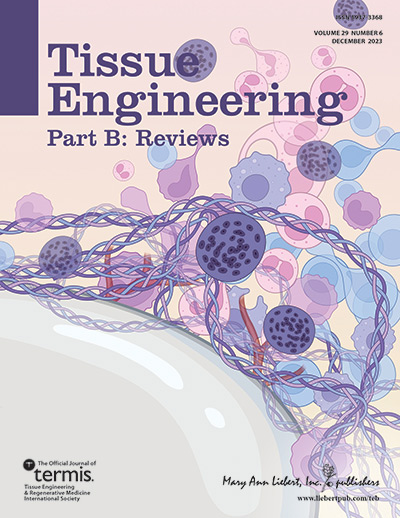The effects of hypoxia-preconditioned Dental Stem Cell-derived Secretome on tissue regeneration.
IF 5.1
2区 医学
Q2 CELL & TISSUE ENGINEERING
引用次数: 0
Abstract
Mesenchymal stem cells (MSCs) derived from oral tissues are known as dental stem cells (DSCs). Due to their unique therapeutic niche and clinical accessibility, DSCs serve as a promising treatment option for bone defects and oral tissue regeneration. DSCs exist in a hypoxic microenvironment in vivo, which is far lower than the current 20% oxygen concentration utilized in in vitro culture. It has been widely reported that the application of an oxygen concentration less than 5% in the culture of DSCs is beneficial for preserving stemness and promoting proliferation, migration and paracrine activity. The paracrine function of DSCs involves the secretome, which includes conditioned media (CM) and soluble bioactive molecules, as well as extracellular vesicles (EVs) extracted from CM. Hypoxia can play a role in immunomodulation and angiogenesis by altering the protein or nucleic acid components in the secretory group, which enhances the therapeutic potential of DSCs. This review summarizes the biological characteristics of DSCs, the influence of hypoxia on DSCs, the impact of hypoxia on the secretory group of DSCs, and the latest progress on the use of DSCs secretory group in tissue regeneration based on hypoxia pretreatment. We highlighted the multifunctional biological effect of hypoxia culture on tissue regeneration and provided a summary of the current mechanism of hypoxia in the pretreatment of DSCs.缺氧条件下牙科干细胞衍生的 Secretome 对组织再生的影响。
源自口腔组织的间充质干细胞(MSCs)被称为牙科干细胞(DSCs)。由于其独特的治疗定位和临床可及性,牙科干细胞是治疗骨缺损和口腔组织再生的一种很有前景的治疗选择。DSCs 在体内存在于缺氧微环境中,其缺氧浓度远低于目前体外培养中使用的 20% 氧浓度。据广泛报道,在培养 DSCs 时使用低于 5%的氧气浓度有利于保持干性,促进增殖、迁移和旁分泌活性。DSCs的旁分泌功能涉及分泌组,其中包括条件培养基(CM)和可溶性生物活性分子,以及从CM中提取的细胞外囊泡(EVs)。缺氧可通过改变分泌组中的蛋白质或核酸成分在免疫调节和血管生成中发挥作用,从而提高 DSCs 的治疗潜力。本综述概述了 DSCs 的生物学特性、缺氧对 DSCs 的影响、缺氧对 DSCs 分泌组的影响以及基于缺氧预处理的 DSCs 分泌组在组织再生中的应用的最新进展。我们强调了低氧培养对组织再生的多功能生物学效应,并对目前低氧预处理 DSCs 的机制进行了总结。
本文章由计算机程序翻译,如有差异,请以英文原文为准。
求助全文
约1分钟内获得全文
求助全文
来源期刊

Tissue Engineering. Part B, Reviews
Biochemistry, Genetics and Molecular Biology-Biochemistry
CiteScore
12.80
自引率
1.60%
发文量
150
期刊介绍:
Tissue Engineering Reviews (Part B) meets the urgent need for high-quality review articles by presenting critical literature overviews and systematic summaries of research within the field to assess the current standing and future directions within relevant areas and technologies. Part B publishes bi-monthly.
 求助内容:
求助内容: 应助结果提醒方式:
应助结果提醒方式:


